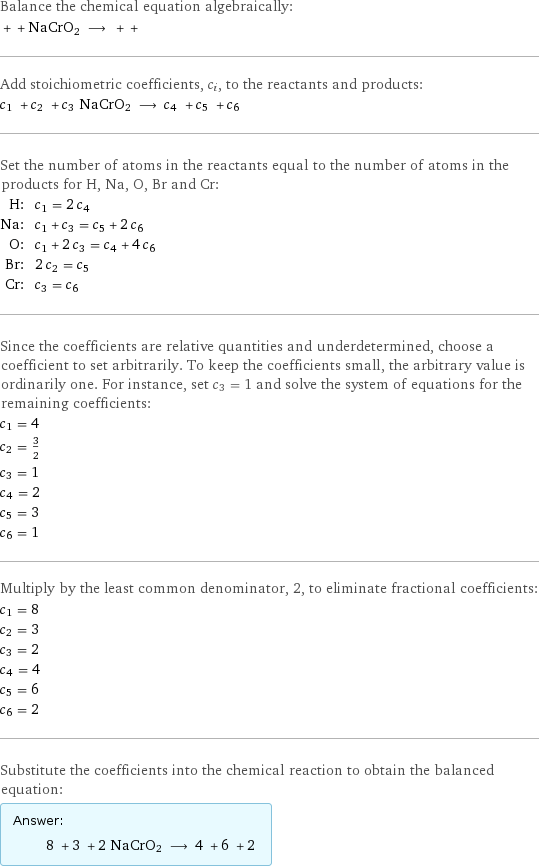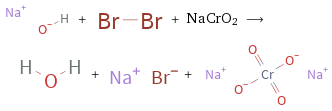Input interpretation

sodium hydroxide + bromine + NaCrO2 ⟶ water + sodium bromide + sodium chromate
Balanced equation

Balance the chemical equation algebraically: + + NaCrO2 ⟶ + + Add stoichiometric coefficients, c_i, to the reactants and products: c_1 + c_2 + c_3 NaCrO2 ⟶ c_4 + c_5 + c_6 Set the number of atoms in the reactants equal to the number of atoms in the products for H, Na, O, Br and Cr: H: | c_1 = 2 c_4 Na: | c_1 + c_3 = c_5 + 2 c_6 O: | c_1 + 2 c_3 = c_4 + 4 c_6 Br: | 2 c_2 = c_5 Cr: | c_3 = c_6 Since the coefficients are relative quantities and underdetermined, choose a coefficient to set arbitrarily. To keep the coefficients small, the arbitrary value is ordinarily one. For instance, set c_3 = 1 and solve the system of equations for the remaining coefficients: c_1 = 4 c_2 = 3/2 c_3 = 1 c_4 = 2 c_5 = 3 c_6 = 1 Multiply by the least common denominator, 2, to eliminate fractional coefficients: c_1 = 8 c_2 = 3 c_3 = 2 c_4 = 4 c_5 = 6 c_6 = 2 Substitute the coefficients into the chemical reaction to obtain the balanced equation: Answer: | | 8 + 3 + 2 NaCrO2 ⟶ 4 + 6 + 2
Structures

+ + NaCrO2 ⟶ + +
Names

sodium hydroxide + bromine + NaCrO2 ⟶ water + sodium bromide + sodium chromate
Equilibrium constant
![K_c = ([H2O]^4 [NaBr]^6 [Na2CrO4]^2)/([NaOH]^8 [Br2]^3 [NaCrO2]^2)](../image_source/ea5b44a40ced39f467586d81aa9b32f0.png)
K_c = ([H2O]^4 [NaBr]^6 [Na2CrO4]^2)/([NaOH]^8 [Br2]^3 [NaCrO2]^2)
Rate of reaction
![rate = -1/8 (Δ[NaOH])/(Δt) = -1/3 (Δ[Br2])/(Δt) = -1/2 (Δ[NaCrO2])/(Δt) = 1/4 (Δ[H2O])/(Δt) = 1/6 (Δ[NaBr])/(Δt) = 1/2 (Δ[Na2CrO4])/(Δt) (assuming constant volume and no accumulation of intermediates or side products)](../image_source/aa00d537ea718ed58f7e30c931cc7905.png)
rate = -1/8 (Δ[NaOH])/(Δt) = -1/3 (Δ[Br2])/(Δt) = -1/2 (Δ[NaCrO2])/(Δt) = 1/4 (Δ[H2O])/(Δt) = 1/6 (Δ[NaBr])/(Δt) = 1/2 (Δ[Na2CrO4])/(Δt) (assuming constant volume and no accumulation of intermediates or side products)
Chemical names and formulas

| sodium hydroxide | bromine | NaCrO2 | water | sodium bromide | sodium chromate formula | | | NaCrO2 | | | Hill formula | HNaO | Br_2 | CrNaO2 | H_2O | BrNa | CrNa_2O_4 name | sodium hydroxide | bromine | | water | sodium bromide | sodium chromate IUPAC name | sodium hydroxide | molecular bromine | | water | sodium bromide | disodium dioxido(dioxo)chromium